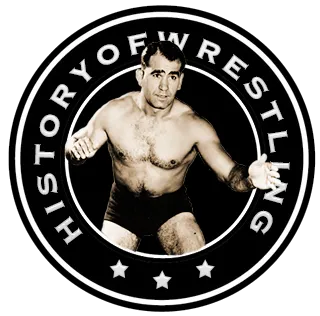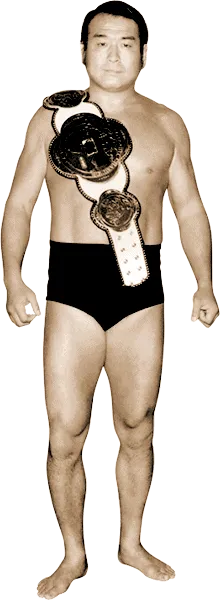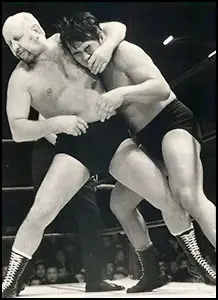by Stephen Von Slagle
Whether it is due to an ever-changing fanbase, a lack of emphasis placed on it by the promotions, or just an overall disinterest in the sports’ past, the history of professional wrestling is often under-appreciated or forgotten by the current wrestling fan. As a result, there are, unfortunately, a great number of “unsung heroes” of the sport, forgotten men who were absolutely pivotal factors in the direction and success of the modern wrestling product. While these talented, innovative individuals forever changed the face of professional wrestling, there names are, generally speaking, unknown to the vast majority of people who would otherwise consider themselves to be knowledgeable fans. Hiro Matsuda, the Japanese technician who would, in many different ways, revolutionize pro wrestling is truly one of those forgotten figures.
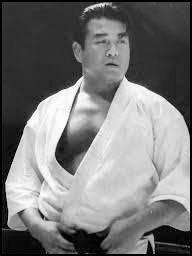 Matsuda was born Yasuhiro Kojima on July 22, 1937 in Yokohama. After excelling at sports during his youth, particularly baseball, Kojima made the decision to enter professional wrestling and was initially trained for a career in the ring by Rikidozan. Later, both Karl Gotch and Diablo Velasco also schooled Kojima in the grappling arts, adding greatly to the future star’s impressive repertoire. He made his pro debut in 1957, competing for Japan Pro Wrestling, where he spent the first three years of his career before leaving his homeland to travel abroad. Using the ring name Ernesto Kojima, he competed in Peru and Mexico before eventually making his way to the U.S. By the early Sixties, Kojima, now billed as Hiro Matsuda, had started to make a name for himself in promotions such as Central States, Stampede, and Mid America, as well as southern NWA territories like Georgia and Florida.
Matsuda was born Yasuhiro Kojima on July 22, 1937 in Yokohama. After excelling at sports during his youth, particularly baseball, Kojima made the decision to enter professional wrestling and was initially trained for a career in the ring by Rikidozan. Later, both Karl Gotch and Diablo Velasco also schooled Kojima in the grappling arts, adding greatly to the future star’s impressive repertoire. He made his pro debut in 1957, competing for Japan Pro Wrestling, where he spent the first three years of his career before leaving his homeland to travel abroad. Using the ring name Ernesto Kojima, he competed in Peru and Mexico before eventually making his way to the U.S. By the early Sixties, Kojima, now billed as Hiro Matsuda, had started to make a name for himself in promotions such as Central States, Stampede, and Mid America, as well as southern NWA territories like Georgia and Florida.
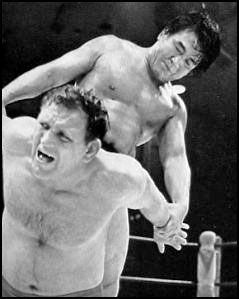 As was the case with nearly every athlete from the Orient who wrestled in the U.S. during this time period, Matsuda was given the traditional “evil Japanese” wrestling gimmick by promoters. Yet, despite being pigeon-holed by the constraining, stereotypical persona, Matsuda was nevertheless able to allow his vast knowledge of mat wrestling and technical prowess to shine through. Without a doubt, Matsuda was hated by the audiences he performed in front of during the Sixties and Seventies and there were few foreign wrestlers of the day who attracted more negative reactions from the fans. However, in a true testament to his ability as a heel, many of those same fans also held a great deal of grudging respect for the devious, unmerciful, yet highly talented Matsuda.
As was the case with nearly every athlete from the Orient who wrestled in the U.S. during this time period, Matsuda was given the traditional “evil Japanese” wrestling gimmick by promoters. Yet, despite being pigeon-holed by the constraining, stereotypical persona, Matsuda was nevertheless able to allow his vast knowledge of mat wrestling and technical prowess to shine through. Without a doubt, Matsuda was hated by the audiences he performed in front of during the Sixties and Seventies and there were few foreign wrestlers of the day who attracted more negative reactions from the fans. However, in a true testament to his ability as a heel, many of those same fans also held a great deal of grudging respect for the devious, unmerciful, yet highly talented Matsuda.
As a Junior Heavyweight, Hiro Matsuda was one of the elite workers in the division and a two-time NWA World Jr. Heavyweight champion who wrestled and defended the title in territories across the U.S., as well as in Mexico & Canada. As champion, Matsuda engaged in heated feuds with the likes of Angelo Savoldi and Ken Mantell, however, the rivalry between Matsuda and Danny Hodge, who many considered to be the best Junior Heavyweight of his era (and perhaps of all time) was truly legendary. It was Matsuda who ended Hodge’s first reign as champion when he defeated the Oklahoma shooter on July 11, 1964. For years, the Hodge-Matsuda feud was one of the biggest match-ups on the Junior Heavyweight circuit and their classic bouts helped keep the often overlooked weight division on the minds of the wrestling world. More than a decade later, the legendary Hodge gained his revenge by ending Matsuda’s second reign as the NWA World Jr. Heavyweight champion when he defeated the Japanese grappler on March 2, 1976 in Shreveport, Louisiana.
In addition to his two reigns as the NWA World Junior Heavyweight champion, Matsuda also wore several Heavyweight titles, the most prominent being the NWA Southern Heavyweight championship, which he captured on three occasions. Matsuda also won Jim Crockett, Sr.’s version of the Southern championship in 1968. Excelling at Tag Team competition as well, Matsuda won the Florida Tag Team title on four occasions, the NWA World Tag Team title with Antonio Inoki in 1966, and the All-Asian Tag Team title with Michiaki Yoshimura, also in 1966.
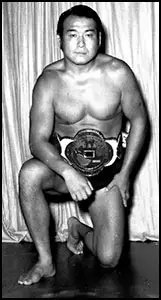 Following a noteworthy career, Matsuda essentially retired from active competition in the late Seventies, although he did continue to wrestle sporadically through to the early/mid Eighties. However, despite the fact that he was no longer on television, Matsuda was still very much a part of the wrestling world. He was a key member of the Florida territory’s ownership team and served as one of Eddie Graham’s most important lieutenants. Meanwhile, as a trainer, Matsuda truly excelled and he was one of the most demanding — and successful — in the business. A master of his craft, Matsuda tutored many clumsy young powerhouses who were breaking into the business, giving them the knowledge and skillset needed to become some of the top stars in the business. Among his impressive list of former students are men like Hulk Hogan, Paul Orndorff, Scott Hall, Ron Simmons, The Great Muta, Riki Choshu, Lex Luger, Hercules Hernandez, Brian Blair and many others. Ironically, but not surprisingly, Blair later stated that Matsuda never received an extra dime for the countless hours he spent in the gym training these men for their careers in the wrestling industry.
Following a noteworthy career, Matsuda essentially retired from active competition in the late Seventies, although he did continue to wrestle sporadically through to the early/mid Eighties. However, despite the fact that he was no longer on television, Matsuda was still very much a part of the wrestling world. He was a key member of the Florida territory’s ownership team and served as one of Eddie Graham’s most important lieutenants. Meanwhile, as a trainer, Matsuda truly excelled and he was one of the most demanding — and successful — in the business. A master of his craft, Matsuda tutored many clumsy young powerhouses who were breaking into the business, giving them the knowledge and skillset needed to become some of the top stars in the business. Among his impressive list of former students are men like Hulk Hogan, Paul Orndorff, Scott Hall, Ron Simmons, The Great Muta, Riki Choshu, Lex Luger, Hercules Hernandez, Brian Blair and many others. Ironically, but not surprisingly, Blair later stated that Matsuda never received an extra dime for the countless hours he spent in the gym training these men for their careers in the wrestling industry.
In 1985, following the unexpected and tragic suicide of Florida promoter Eddie Graham, Matsuda stepped in and tried to help fill the huge void left by Graham’s death. Along with partner Duke Keomuka, Matsuda (who was already a minority owner in the promotion) bought-out the territory and ran the NWA’s Florida promotion, once one of the most successful of all the NWA’s many groups, beginning in January of 1985. However, the fallout from Graham’s death, combined with heavy competition from the ever-invading WWF and an ongoing loss of top talent, eventually forced Matsuda to sell the promotion to Jim Crockett’s NWA group in February of 1987.
The next time Matsuda was seen on a national stage was in 1989, when, following the departure of J.J. Dillon from the NWA to work in the rival WWF’s front office, Matsuda appeared on J.C.P. programming as the manager of NWA World Heavyweight champion Ric Flair (as well as then-U.S. champion Barry Windham) during the post-Horsemen era. As the Japanese business agent for the J-Tex Corporation, Matsuda played an important part in the top storylines of the NWA during the late Eighties.
With the new decade of the Nineties came innovative fresh challenges for the respected Matsuda, most notable of which was his role in launching Ring Warriors, which was an internationally syndicated television version of New Japan Pro Wrestling. While Ring Warriors was a relative success on European TV, it made a far more memorable and lasting impact online. The Ring Warriors website was a genuine innovator in the field during the internet’s mid-1990s infancy and it was the first site (by several years) to feature streaming video of its wrestling product. Ultimately, the technology of the era was insufficient to fully support the lofty endeavor, however, the idea of online video content that Matsuda and his business partner Howard Brody pioneered eventually proved to be truly revolutionary.
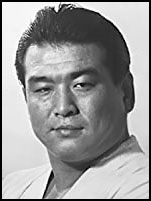 Matsuda received the prestigious Tokyo Sports Service Award in 1999, and is a member of the WWE Hall of Fame (2018) as well as the Professional Wrestling Hall of Fame (2018).
Matsuda received the prestigious Tokyo Sports Service Award in 1999, and is a member of the WWE Hall of Fame (2018) as well as the Professional Wrestling Hall of Fame (2018).
Following a lengthy battle with colon cancer, Yasuhiro “Hiro Matsuda” Kojima died on November 27, 1999 at the age of 62.
